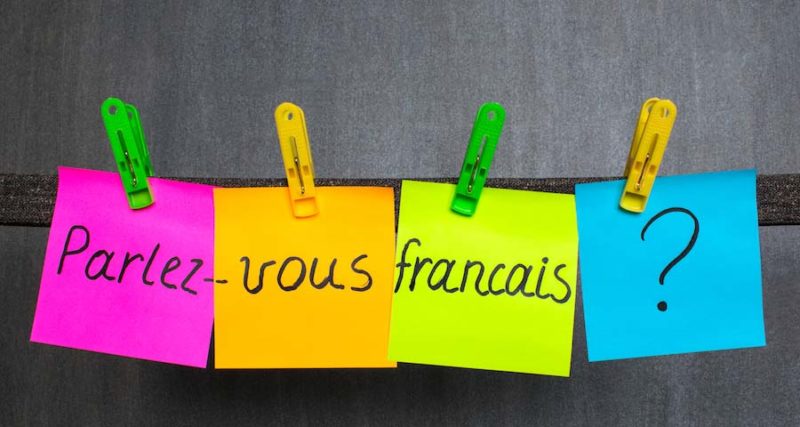Learn How to Write Sentences in French
Reaching French fluency is an awesome experience. But, to get there, you need to know how to write French sentences. French sentence structure is a crucial part of grammar. Luckily, it doesn’t take long to master them. Here’s everything you need to know about French sentence structures, how to form questions, and how to turn a sentence negative in French. Reach fluency faster with this knowledge.
The Basics of French Sentence Structure
French and English are very similar languages. So, if your native language is English, you’re in luck. French grammar won’t be difficult to master. Generally speaking, French sentence structure is almost identical to English sentence structure. A basic statement in French sentence structure would follow a subject-verb-object (SVO) word order.
- I eat apples. Je mange des pommes.
I (je) is the subject, eat (mange) is the verb, and apples (des pommes) is the object. This is true when you start to add adjectives as well, except that in French some adjectives (like color) come after the noun.
- I eat beautiful red apples. Je mange de belles pommes rouges.
The Flexibility of French Sentence Structures
Of course, this SVO word-order is not written in stone. Just like in English, there’s flexibility in sentence structure in French. You can switch the building blocks slightly, and it’s still a grammatically correct sentence. Here’s an example:
- Tomorrow, I’m going to work. Demain je vais travailler.
I’m going to work tomorrow. Je vais travailler demain.
This is a great example of how word order can be used to communicate information. Whatever you put in front has more stress. So, if you want to emphasize that “tomorrow” is the day you’re going to work, you put that word to the front. Whereas with “I’m going”, you’re stressing that you’re the one completing the action.

Forming and Asking Questions in French
Like English, there are various ways to ask a question in French. You can convey different meanings, and focus on different answers with the different types of questions in French. You have three main options to form French questions:
1) Use of question words
2) Use of inflection
3) Switching subject and verb order
Because it has gendered nouns, French requires some changes to pronouns and adjectives when forming questions.
1. Use of Question Words
Adding question words to the beginning of a sentence is a simple way of creating a sentence in French. The most common is the phrase “Est-ce que” at the beginning of a sentence with a verb, or “Est-ce” with only a noun.
- Do you speak Engish? Est-ce que vous parlez anglais ?
- Is this the right way? Est-ce la bonne façon ?
- Is the food good? Est-ce que la nourriture est bonne ?
The following are some of the most common French questions words:
How Comment
What Que / Qu’est-ce que que
What kind Quel genre
When Quand
Where Où
Who Qui
Why Pourquoi
2. Addition at the End of a Sentence
French lets you add a little something to the end of a sentence to turn it into a question. Naturally, you need to add inflection to this addition for it to reflect your meaning. Just like you can say “We are going to the park, right?” or “We had a great time, didn’t we?” to form questions, you can do this in French as well. The difference is that you can do it with a single phrase to make it much easier – “n’est-ce pas.”
We’re going in the right direction, right? Nous allons dans bonne direction, n’est-ce pas ?
We had a great time, didn’t we? Nous avons passé un très bon moment, n’est-ce pas ?
This is probably the most common way of forming a question in French – so much so that it is a bit of a cliché in the way people imitate the way the French speak.
3. Switching Subject and Verb Order
The last way to form a sentence is similar to the most common way to form a question in English, by switching the order of the subject and verb. Place the verb first, and make the subject second to form a questions, adding a “-” in between.
Do you speak English? Parlez-vous anglais ?
Did he leave? Est-il parti?
Can you help us? Pouvez-vous nous aider?
Note: when the verb ends with a vowel, you must add a “t” between the verb and the subject.
Does he speak well? Parle-t-il bien?

4. Changing Pronouns and Adjectives
You may have noticed that common question word “which“ has not been covered yet, and that is because it requires changing the pronouns and adjectives to properly convey the question. This is because pronouns and adjectives reflect the gender of the noun, as well as whether the noun is singular or plural.
| Gender, number | Which | Which one |
|---|---|---|
| Masculine singular | quel | lequel |
| Feminine singular | quelle | laquelle |
| Masculine plural | quels | lesquels |
| Feminine singular | quelles | lesquelles |
How Gendered Nouns Change French Sentences
You need to substitute the right form of which to the sentence to reflect the gendered noun.
- Which book is yours? Quel livre est le tien ?
- Which blanket do you want? Quelle couverture veux-tu ?
- Which one is yours? Lequel est à too ?
- Which one do you want? Laquelle veux-tu ?
Though you may expect it to change, the use of “who” does not change based on gender. “Qui” is equivalent to who, which is gender-neutral because you don’t know the answer when you ask it.
- Who is there? Qui est là ?
When you ask “whom”, you have to add “à” before “qui”. That’s why French people often “to who?” in English.
- Whom did you visit? À qui avez-vous rendu visite ?
When you need to ask “whose,” add “à” before “qui” to express the possessive form of “who” and “whom.”
- Whose car is that? À qui est cette voiture ?
“What” changes based on its function within the sentence. Use “qu’est-ce qui” as the subject to reflect “what.”
- What is going on? Qu’est-ce qui se passe ?
Use “que” or “qu’est-ce que” when you need to express “what” as an object.
- What is it? Qu’est-ce que c’est ?
- What did you say? Qu’est-ce que vous avez dit ?
Use “qu’est-ce que” or “qu’est-ce que c’est que” when you need to express “what” to ask for an explanation.
- What is that? Qu’est-ce que c’est que ça ?
- What is a democracy? Qu’est-ce qu’une démocratie ?
Finally, use “quoi” to express “what” as a prepositional object.
l.What? Quoi ?
What is she in charge of? De quoi est-elle responsible ?
Useful Question Phrases in French
With so many rules governing how to express a question, it may be heplful to simply memorize a few simple phrases. This will not only help you start talking a little faster, it will give you more concrete examples of the way to express phrases that you will likely need.
How much does it cost? Combien ça coûte ?
How do you get to town? Comment arrivez-vous en ville ?
When does the train arrive? Quand arrive le train ?
Why are you upset? Pourquoi es-tu agacé ?
Forming Negative Sentence Structures in French
Compared to English’s one addition (no or not), a negative sentence in French requires two additions: “ne” or “n’” (depending on the first letter of the verb) and “pas.” Take the following examples:
I do not want food. Je ne veux pas de nourriture.
I did not walk far. Je n’ai pas marché loin.
Learn French Sentence Structures Naturally
As you progress with your French studies, you’ll soon find that French sentence structures aren’t difficult to master at all. In fact, you’ll get a natural feel for them if you learn high-frequency phrases. These sentences and expressions are the most useful in French. And if you want to know exactly which ones these are, download OptiLingo.
OptiLingo collected all the most useful and crucial sentences in French. Teaching you exactly how the locals speak, this app will surely bring your results. You can reach fluency faster by not wasting time on unnecessary vocabulary. Just learn what you really need. Download OptiLingo today to learn French sentence structures easily!







